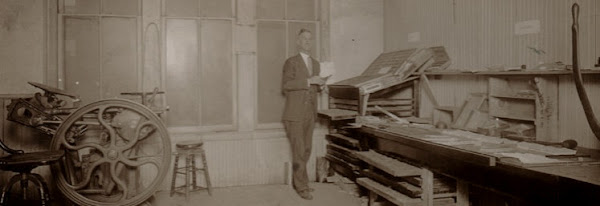I've been on a slight hiatus from posting because I've been without a computer at home for about three weeks. I had an ancient 366 mhz unit that I've exchanged for a less ancient Pentium III at about 800 mhz. I still have dialup so dowloading, etc. is as slow as before, but aside from that I'm cookin' with gas. And it doesn't lock up every few websites. And it has Windows 2000 and Corel Draw, and it's the best thing since sliced bread. Now I'm loking into DSL. Yep, I'm moving right into the 90's.
Anyway, in honor of the first post since my return, I have a nice new addition to the shop to introduce, a National wire stitcher. While I don't plan on doing thousands of binding jobs of my own work, I will do some and want to have the option of doing binding for others on a paying basis. Besides, it's a cool machine and I love machines and because I only paid $50 for it and picked it up locally, I indulged myself.
I picked it up today and while I wasn't surprised by its overall dimensions which were about what I expected, I didn't realize it was so beefy. It's made of heavy castings and is very substantial. I still need to look into its particular specifications, but it certainly looks heavy enough to bind up to at least an inch thick as opposed to the smaller, lighter models.
It was made by the Gitzendanner-Muller Co., Inc. of New York, NY. It's their National Wire Stitcher, Size #8, serial number 1325. There is a supplier's tag on it as well showing that it was sold by the E.P. Lawson Co. Inc. of 426 W. 33rd St., New York 1, NY. The tag indicates they sold paper cutting machines and binding equipment and probably a lot of other things related to printing.
I'm estimating it is from the 30's. This is based on the paint color, style of the maker's and seller's tags, etc. The "New York 1, NY" will be a clue that I have yet to look into. It had a wooden wire spool with some 28 guage wire installed. The spool had a paper label from the same company as the maker of the stitcher but because the label was partly falling off and partly damaged I was able to see that it had been glued over a label from the actual maker of the wire. This is not uncommon as for example Martin guitar strings are sold in Martin packaging but are actually made by a company that makes strings as their main business. I wish stitching wire sold today still came on wooden spools instead of ugly, bright colored plastic. I repired the lbel and reattached it to the spool. Gotta love that wooden spool.
The stitcher is dirty with minor rust on some exposed parts but otherwise seems complete and cycled through when I turned it by hand. I need to replace the cord. If anyone could provide me with scanned catalog pages, instructions, or any other information on this particular stitcher or a similar stitcher I would really appreciate it. I'm pretty good mechanically but am flying blind with this machine.
The photos below were taken by the man I bought it from and aren't so good. I'll take some better ones and post them later.




